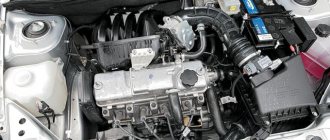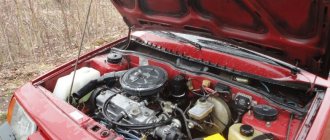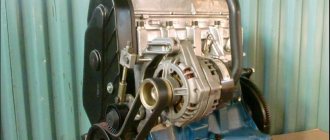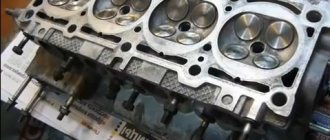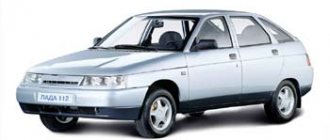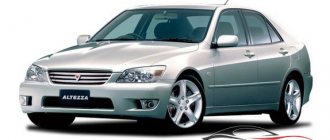Engine 11183 is the engine installed on the cheapest versions of budget VAZ cars: the Lada Kalina sedan (2001 - 2011) and the Lada Granta model that replaced it (2011). They replaced the Samara family of cars that had been produced for a long time.
The VAZ 11183 engine is a product of modernization of the well-known 2111 engine, which in turn replaced the outdated (carburetor) 21083.
Engine 11183 (another name for VAZ 21114 engine) differs from 2111 (cylinder capacity 1.5 liters):
- height of the cylinder block;
- increased piston stroke.
Due to this, the designers managed to increase the volume of the cylinders and increase the engine power. As a result of the work carried out, engine 11183 significantly improved its performance characteristics (reliability, environmental friendliness, etc.). Due to the fact that its assembly is carried out at various production sites of AvtoVAZ OJSC, the engine is known to car enthusiasts under the names:
- 11183;
- engine 21114;
- 2114;
- Kalina motor;
- motor Kalina, etc.
Specifications
Download .xls file
xls
Download picture
Send by email
| PARAMETER | MEANING |
| Cylinder displacement, cubic meters cm | 1.596 |
| Rated power, l. With. (at 5200 rpm) | 82 |
| Maximum torque, Nm (at 2700 rpm) | 120 |
| Number of cylinders | 4 |
| Number of valves per cylinder, pcs. | 2 |
| Total number of valves, pcs. | 8 |
| Cylinder diameter, mm | 82 |
| Piston stroke, mm | 75.6 |
| Spark plug | A17 DVRM, BPR6ES (NGK), etc. |
| Cylinder operation diagram | 1 — 3- 4- 2 |
| Supply system | Injector (electronically controlled distributed injection) |
| Fuel | Unleaded gasoline AI-92 |
| Fuel consumption, l./100 km. (city/highway) | 8,8/5,7 |
| Lubrication system | Combined (spraying + under pressure) |
| Engine oil type | 5W-30, 5W-40, 10w-30 and 10W-40 |
| Engine oil quantity, l | 3.5 |
| Cooling system | Liquid, closed type |
| Coolant | Based on ethylene glycol |
| Motor resource, thousand hours. (theory/practice) | 150/300 |
| Weight, kg | 127 |
The engine is installed on cars produced by VAZ: Lada Samara 2 family; Sedan Lada Kalina (2004 - 2013); Lada Granta 1.6 l., 8-cl., manual transmission (2011-present).
Engine VAZ 11183 1.6 8v 80/82 hp: characteristics, reliability, efficiency, service life and problems
Good afternoon, today we will review
the 8-valve naturally aspirated gasoline engine
Lada Granta
/
Kalina
,
Datsun On-Do
-
VAZ 11183
volume
1
.
6 liters
(
power: 80/82 horsepower, torque: 120/132 Newton per meter
) and consider technical characteristics, distinctive features, reviews from car owners, service life, service intervals, practicality in repair/maintenance, the most common problems (
sores and malfunctions
), as well as the pros/cons of the power unit.
VAZ 8 valve
line costs , which is installed on budget car models that are in demand in Russia, such as
the Lada Kalina
/
Granta
, as well as
the Datsun On-Do
(
in different body styles
).
The engine is of domestic production,
VAZ
series
11183,
volume
1
.
6 liters
for
8 valves
, was first demonstrated to the public in 2004 at the exhibition pavilion of the
AvtoVAZ
in Tolyatti, installed on a
Lada Kalina
sedan.
For reference, we note that the medium-volume power unit VAZ 11183
1.6 liters 8 valves was assembled from 2004 to 2022.
The production of the motor in question was launched together with its brother in the 21114
in Togliatti, but in different workshops.
According to auto experts, the 11183
, created by engineers of the Volzhsky Automobile Plant, has a fairly simple design and design, compared to many other internal combustion engines of the 8-valve AvtoVAZ line.
Since 2004, the reviewed power plant is 11183 1
.
6
was standardly installed on the
Lada Kalina 1118
(
sedan
),
Lada Kalina 1119
(
hatchback
),
Lada Kalina 1117 (station wagon
), since 2011 on
the Lada Granta 2190
(
sedan
) and since 2014 on the
Datsun On-Do 2113
(
sedan
).
Into the line of gasoline internal combustion engines " VAZ 8 v"
"includes:
1
.
6 1118 2
,
1
.
6 11186
,
1
.
6 11189
,
1
.
6 21114
and
1
.
6 21116
.
{banner_adsensetext} How does
the VAZ ICE series 11183 1
and ?
6 liters ?
First, we note that in 2011, AvtoVAZ developed an unusual modification of the
11183
E-gas
pedal , which received its own serial number -
11183-50
.
As for the regular version of the engine, it does not particularly stand out from its fellow 8-valve engine family. For example, the base of the power unit is carried by a cast-iron cylinder block ( 4 cylinders, in-line arrangement
) and an aluminum head designed for 8 valves with an overhead camshaft. The valves in this internal combustion engine are driven by cams using pushers. Hydraulic compensators are not provided in the power plant, so valve clearances must be periodically adjusted by selecting steel washers.
In general, the cylinder block of the engine in question is practically no different from the power unit of the
VAZ
21083
series , but the head, of course, is equipped with an injector. In addition, the differences include phased fuel injection, which replaced pairwise-parallel injection, a modified piston stroke from 71 to 75.6 millimeters and an increased cylinder displacement from 1.5 to 1.6 liters.
The gas distribution mechanism in the reviewed engine is belt driven
with a manual tension mechanism, so from time to time car owners have to tighten it to the desired condition.
The strength of the power unit of the 11183
is a very significant fact, which directly relates to the fact that when developing the internal combustion engine, the manufacturer used pistons with holes on the bottom, so if the
timing belt
breaks, the valves do not bend, the engine simply stalls and that’s all.
For reference, we note that in 2011 a deep modernization of the VAZ engine was carried out 11183 1
.
6
(
produced from 2011 to 2022
), as a result of which the power plant acquired a large receiver and an electronic throttle control mechanism with the
“E-Gas
” type of action.
The modernized version received its own index 11183-50
and differs from the usual in increased power (
increased from 80 to 82 horsepower
) and torque (
increased from 120 to 132 Newton per meter
).
{banner_reczagyand}
Technical characteristics and specifics of the VAZ 11183 engine 1
.
6 liters 8 valves
What gasoline consumption is characterized by the power unit of the 11183 series 1
.
6 8v from VAZ ?
Which cars (generation, body version and years of production) are equipped with the VAZ 11183 1 internal combustion engine
.
6 8v ?
What are the advantages and disadvantages are typical for the VAZ power unit of the 11183 series 1
.
6 liters?
Many car owners of cars with such an engine unanimously declare that the internal combustion engine of the series 11183
quite strong, and it will be even more reliable than the old and time-tested VAZ units.
Auto mechanics claim that the quality of the main components of this unit has noticeably increased, although not significantly, but still. For reference, we note that official dealers strongly recommend adjusting the valve clearances at every maintenance ( every 15 thousand kilometers
), however, in reality, there is absolutely no need to carry out this procedure frequently (just money down the drain). As a rule, it is enough to just adjust the valve clearances once every 60-75 thousand kilometers.
What problems and breakdowns is the engine famous for? 11183 1
.
6 liters for 8 valves from VAZ ?
Based on a large number
of reviews
from car owners and expert opinions of specialists, which are freely available on the Internet on the portals Drive2.ru/Drom.ru, popular among car enthusiasts, we have especially compiled for you a generalized list with the main problems (
factory problems
) that most often arise during the operation of the VAZ power
1
.
6-liter
unit series
11183
.
1
.
With the engine at idle
. In general, it would be hard to call the engine in question quiet. As a rule, this internal combustion engine operates loudly, and this applies to both cold and heated ones (the sound even sometimes resembles a folk diesel engine). Note that such sounds cannot be called a breakdown - this is a structural feature, so to speak. In addition, extraneous noise and knocking can be caused by out-of-adjustment valves. However, if the knocking occurs when it is cold and you have recently adjusted the valves, then most likely there is something serious in this, so it is advisable to immediately contact the nearest garage or service center.
2
.
Frequent overheating
.
Frequent overheating is no longer considered news for most modern VAZ engines. As a rule, such problems are caused by an unfinished thermostat at the factory, which systematically fails. There are even such situations, especially in winter, when they just replaced the old thermostat with a new one, but the internal combustion engine does not heat up at all. Thus, the quality of domestic parts is sometimes quite low, and there are no imported analogues on the market as such. 3
.
The engine stalls while driving
.
In the event that your Datsun or Lada suddenly suddenly stalls right on the move, then many experienced car enthusiasts will immediately answer that most likely the problem lies in one of the sensors ( most often the mass air flow sensor fails
) and it needs urgent replacement.
4
.
Engine oil leaks
.
Lubricant leaks in this power unit occur quite often, and this also applies to new engines that have just come off the assembly line. In most cases, the problem lies in ill-conceived seals (oil seals
), from under which oil oozes; this problem is especially typical for valve cover gaskets.
5
.
Glitchy electrical
.
All electrical problems in the motor in question one way or another come down to the electronic control unit ( model 11183-1411020 52
).
This problem is quite common, so in most specialized auto stores you don’t even have to mention the part number we specified, since many sellers already remember it by heart. 6
.
Engine tripping at idle
.
In the engines under review, it is quite rare, but still, valve burnouts occur, directly related to the low quality of the fuel being filled, or simply because the clearances have not been adjusted for a long time. However, tripping can also be caused by short-lived spark plugs and a 4-pin ignition coil. 7
.
Floating speed at idle
.
There are many reasons why floating speeds occur, but often the culprit of such a problem is malfunction of the sensors or excessive contamination of the throttle valve. 8
.
Lethal malfunctions
. As a rule, auto mechanics primarily attribute this type of breakdown to the appearance of a dull metallic knock when accelerating a car, and as it picks up speed, it rapidly increases. In most cases, such knocking noises are caused by high wear of the connecting rod or main bearings of the crankshaft, as a result of which the car owner will have to prepare for a major overhaul.
Service regulations 1
.
6-liter VAZ engine series 11183 with 8 valves
As a rule, at AvtoVAZ,
Rosneft Maximum 5W-40
/
10W-40
.
The scheduled maintenance interval for internal combustion engines is every 15 thousand kilometers or once a year, and after one maintenance ( every 30 thousand kilometers
) the spark plugs and air filter are changed. In addition, at a mileage of 90 thousand kilometers, it is necessary to update the alternator belt, and at 120 thousand kilometers, antifreeze will require replacement. According to auto mechanics, it is advisable to carry out maintenance of the power unit in question every 9-10 thousand kilometers in order to maximize the lifespan of the key component of the car.
How much is a new and used power plant 11183 1 valued on the market
?
6 liters 8 valves ?
Today, buying a VAZ contract internal combustion engine of the
11183
at a showroom or on specialized Internet sites is not difficult, the choice is large, and the price range will suit everyone.
The price for a used motor starts from 9-10 thousand Russian rubles ( $150 equivalent
) and reaches 65-70 thousand Russian rubles (
800-900 equivalent
).
A new engine ( without mileage
) is valued at dealers at 85-90 thousand Russian rubles (
115-1250 equivalent
), and with the
E-Gas
about 95-100 thousand Russian rubles ($1300-1400 equivalent).
What analogue engines from other manufacturers are similar in design to the VAZ 11183 1
.
6 8v?
Video: “Description of the modernized VAZ engine series 11183 with a volume of 1.6 liters and 8 valves«
According to the manufacturer, AvtoVAZ, the service life of the 1.6 liter VAZ 11183 series power unit can be 160-180 thousand kilometers before major repairs.
In reality, with systematic compliance with routine engine maintenance by the car owner, the durability of a VAZ gasoline engine often reaches the replacement of 190-200 thousand kilometers. THANK YOU FOR YOUR ATTENTION
.
SUBSCRIBE TO OUR NEWS
.
SHARE WITH YOUR FRIENDS
.
Description
Like all previous models, the VAZ 11183 engine is a classic four-stroke, in-line, 4-cylinder power unit with an overhead camshaft.
The increase in cylinder volume was achieved through the use of a higher cylinder block than that of the prototype. Its height is 2.3 mm higher than the height of the 2111 engine block and is 197.1 mm (from the crankshaft axis to the top surface). The diameter of the cylinders did not change, but the dimensions and shape of the combustion chamber had to be changed.
The cylinder head is made of aluminum alloy. A camshaft is installed in its upper part, and special ducts are cast in the lower part, designed to supply coolant to the combustion chambers. The same channels are also available in the cylinder block housing.
The crankshaft and camshaft of the engine are cast from cast iron, the pistons are made from aluminum alloy. Forged connecting rods (steel).
Peculiarities
The next domestic power unit was designed and put into production only in 2004. Manufacturers took a fairly large number of design elements from the VAZ-21114 engine. The production of internal combustion engines continued for quite a long time, right up to 2017. In 20111, a modified version of the VAZ-11183-50 was released, which was distinguished by the installation of an electronic throttle control drive.
The engine structure uses classic solutions, since it is in-line with four cylinders providing a working volume of 1.6 liters. The characteristics of the VAZ 11183 engine were quite good, since its power was 80 horsepower, and its peak torque reached 120 Nm.
Most specialists in the field of engine maintenance and repair claim that the power unit has a fairly simple design and device when compared with other domestic internal combustion engines that have 8 valves.
High-strength cast iron turned out to be the material from which the VAZ 11183 engine block was cast. The height of this element was increased by 2.3 millimeters in comparison with the VAZ-2110 engine. There were no liners because the cylinders were machined directly into the block.
The cylinder head is made of aluminum. Its design has one camshaft and 8 valves, according to the SOHC system. In order to obtain an increased compression ratio, manufacturers decided to enlarge the combustion chambers. The thermal clearance of the valves will have to be adjusted independently, since hydraulic compensators are not provided in the power unit.
The crankshaft was forged and made exclusively from high-strength steel. Its crank radius had to be increased by 2.3 millimeters in order to achieve a piston stroke of 75.6 millimeters. The timing mechanism is driven by a belt. If the drive belt breaks, the engine will simply stall and the valves will not meet the pistons.
For the normal functioning of the attachments, individual drive belts are used. An injector operating on the principle of distributed fuel injection into the combustion chambers was used as a power system. Many people say that the engine runs great on AI-92 gasoline. This is quite logical, since manufacturers have made the compression ratio less than 10.
The VAZ 11183 engine number is not very difficult to find. To do this, you just need to open the hood, and if you stand facing the car, you can see it on the right side at the end of the frame above the crankcase.
Maintenance
The gas distribution mechanism is driven by a belt, which requires replacement every 45 thousand km. mileage In addition, valve clearances also require periodic adjustment.
A significant advantage of the VAZ 11183 engine is that if the drive belt breaks, hard contact of the valve with the piston surface is eliminated (the valves do not bend).
Maintenance that ensures long-term operation of the power unit comes down to:
- regularly inspect the engine to detect oil and coolant leaks. If any defects are identified, they must be eliminated;
- timely replacement of engine oil - every 15,000 km.
Reliability, weaknesses, maintainability
These three main indicators complement the technical characteristics of the engine in sufficient detail and give a more complete picture of the power unit.
Reliability
VAZ-21114 is one of the few engines with high reliability. Car owners have repeatedly spoken about this on forums. Car service technicians share the same opinion.
For example, the engine of a Lada Kalina 1117 with a mileage of 130 thousand km was inspected. The result was amazing. The pistons are clean, the hone on the cylinder walls is preserved, and there is no carbon deposits on the valves.
The car owner draws attention to the fact that the oil was changed after 7-8 thousand km, and the gasoline for the first 90 thousand km was exclusively AI-95, then it was replaced with AI-92.
Reliability is clearly evidenced by the fact that with a lifespan of 150 thousand km declared by the manufacturer, the engine lasts for more than 300 thousand without repair. And this is not the limit.
The engine has a large margin of safety. With proper tuning, its power can be increased to 180 hp. With. It should be taken into account that such modification of the motor is very complex, expensive and significantly reduces the declared service life.
The reliability of the motor is significantly increased by reducing the maintenance time, using high-quality technical fluids and its reasonable operation.
Weak spots
In general, the VAZ-21114 is considered a successful power unit, but it failed to avoid weak points. According to reviews from car owners and car service workers, the engine has all the VAZ “sores”.
Tendency to overheat. Many have had to deal with this unpleasant phenomenon during operation. The most common cause of overheating is a thermostat and water pump that were not properly adjusted by the manufacturer. If a problem occurs, they will have to be replaced with new ones. There is no other way out of this situation.
Unstable idle speeds cause a lot of trouble. As a rule, they occur when sensors (mass air flow sensor or air flow sensor) fail. Less commonly, due to contamination of fuel supply system elements.
Failed sensors must be replaced. The fuel system needs to be flushed. The malfunction in the first case occurs due to the fault of the plant, and the second falls almost entirely on the shoulders of the car owner.
Refueling with low-quality fuel and untimely maintenance are the main components that cause clogging of the fuel system.
Electrical malfunctions. In this case, the author of the malfunctions is, just like the thermostat and pump, an unfinished ECU (21114-1411020). In addition, the engine often stalls and jerks at idle due to a faulty ignition coil.
Four-terminal ignition coil
The same behavior of the motor can be caused by burnt-out valves if their thermal clearance is not adjusted in a timely manner.
Minor “standard” problems do not bring joy to the car owner, such as oil leaks from under the valve cover, malfunctions of the fuel pump, unauthorized knocking in the engine compartment (usually unadjusted valves knock).
If any malfunction occurs, you must immediately seek help from specialized car service specialists. Timely detection and elimination of the problem in most cases saves the car owner from serious (and therefore costly) engine repairs.
Malfunctions
Motor 11183 is characterized by malfunctions that are typical for all power units produced by AvtoVAZ OJSC.
| FAULTS | CAUSES | REMEDY METHODS |
| The engine does not warm up to the required temperature. | Thermostat is faulty. | Replace thermostat. |
| Knocking and noise in the engine. | 1. Valve clearances are not adjusted. 2. Wear of the crankshaft main bearings. 3. Wear of connecting rod bearings. 4. Pistons knock | Adjust valve clearances. Malfunctions associated with wear of bearings and the need to replace pistons are recommended to be repaired in a specialized car service center. |
| The engine operates unstably (“speeds float”, “troits”, etc.) | 1. The throttle position sensor is faulty. 2. The valve has burned out. 3. The gasket is broken. 4. The ignition module is faulty. | ŸReplace the faulty sensor. Measure compression in cylinders. If it is below normal, then the malfunction is hidden in the gas distribution mechanism. If compression is normal, the fault must be looked for in the ignition module. |
Advantages
The VAZ 11183 engine with 8 valve injector has a fairly large number of positive qualities with which many associate its popularity. Owners of cars with this engine note the following advantages:
- The safety margin of the main elements is reserved by the factory. This leads to the fact that the engine, with the right approach, lends itself well to tuning. At the same time, increasing power to 130-150 horsepower does not affect its service life in any way.
- Many people say that the motor has received a much longer resource in comparison with its brothers. This is a completely justified statement, since it began to be assembled with improved quality components, so with the right approach it can go much further.
- The motor is very unpretentious in operation. Many people pay special attention to the lubrication system, since the quality of the oil is practically unimportant, since there are no hydraulic compensators in the design. Of course, you should follow the manufacturer's recommendations.
- Unpretentiousness to fuel. The compression ratio was increased, but to reasonable limits, and the power system was designed in such a way that the engine copes well with low octane gasoline. This is an excellent solution, given the quality of domestic gasoline.
- Timing belt The main advantage of using an 8-valve mechanism is that if the belt breaks, there is no contact between the pistons and the valves. Therefore, you should not be afraid that unplanned repairs may be required.
Tuning
Engine tuning is most often carried out in order to increase the power above that indicated in the passport. On a VAZ 11183 engine, it can be increased without special costs through a number of sequential operations:
- Increase engine power to 90 hp. With. It is possible if you replace the existing camshaft with “OKB Dinamika 108” or “Nuzhdin 10.93” and install a split gear. With the correct phase settings, the power unit can develop power up to 90 hp. With.
- By installing a receiver, an enlarged 54 mm throttle body and a Spider 4-2-1 exhaust, you can increase the engine power to 100 hp. With.
- After modification of the cylinder head and intake manifold, the engine power will increase to 115 hp. With. True, for this it is necessary to replace the standard valves with lighter ones (T-shaped).
- By replacing the piston group with a lighter one (for example, from a LADA Priora car), we get a power of more than 120 hp. With.
The same result can be obtained if you install on the engine:
- compressor PK-23-1;
- camshaft “Nuzhdin 10.42” or “Nuzhdin 10.63”.
The power of the 8-valve power unit can be further increased, but this will lead to a significant reduction in its service life.
Engine VAZ 21126
The youngest in the line of 16-valve engines. It has stable and good indicators in terms of fuel consumption, dynamics and reliability.
The engine has been in production for quite a long time, many “childhood diseases” have been corrected by the plant at the moment, plus an extensive knowledge base allows this engine to be used and repaired in almost any corner of the post-Soviet space.
The motor was developed with the production of the Lada Priora car and is currently used on all products of the Volzhsky plant with the exception of 4x4 and Lada Largus.
Unlike its predecessor, the VAZ 21124, the new engine received a qualitatively new treatment of the cylinder walls using Federal Mogul technology, which allows for stable quality of working surfaces. The same company was developing a lightweight connecting rod and piston group specifically for this engine and the crankshaft used on it. This approach to design and preparation made it possible to achieve low vibration load and noise levels of the new motor.
Also, unlike simpler 8-valve engines, the VAZ 21126 engine uses hydraulic pushers, which allow you to automatically compensate for the gap in the valve drive. This implementation freed owners from the need for regular adjustments.
To boost the engine more with the existing technical parameters, the engineers increased the compression ratio to 11 units, which is a very high indicator and has a number of requirements for fuel quality.
The qualitative technical characteristics are as follows: maximum power 98 hp. at 5600 rpm, torque 145 N/m at 4000 rpm.
Pros:
- Low vibration and noise levels;
- With a preferential level of transport tax, it has excellent dynamic performance;
- Hydraulic compensators available
- Maintained ease of maintenance;
Minuses:
- Due to the high compression ratio, the use of high-quality fuel not lower than AI-95 is required
- With improper maintenance and high load, it is not uncommon for the timing belt to break, which entails a meeting of the valves with the connecting rod and piston group.
Timing device VAZ 2110 injector 8 valves
Many people are concerned about the question of whether the valves on the injection engine of the VAZ 2110 bend. No, they don’t
. The 8-valve injector does not suffer from this defect. But this does not mean that you should not monitor the timing belt. Because loosening and subsequent jumping of the belt by a certain number of teeth will lead to inevitable problems. It is worth paying special attention if engine oil gets on the belt; an oiled belt will not last long. Below is a detailed image of the timing diagram of the 8-valve injection engine “tens”. See the photo below.
When replacing the timing belt on a VAZ-2110, it is necessary to clearly align the marks on the camshaft and crankshaft pulleys; without this, the engine will not operate normally. Another important point is that when the tension roller moves to its original state, the marks shift as the belt tension changes. Therefore, carefully check whether the timing marks are clearly aligned before putting on the cover covering the timing belt.
Modifications
As a result of certain modifications, the VAZ-11183-50 engine was obtained, which has no fundamental differences from the main model, but thanks to the modifications it was possible to increase power to 82 horsepower, and torque increased by 12 Nm. The environmental standard has also been increased. The main difference is the installation of an electronic throttle control mechanism, which improved engine controllability, but caused problems with the TPS sensor.
Engineers, through modifications, also coped with a number of persistent problems, for example, now the throttle valve in the engine is no longer dirty. The modernization also resulted in increased engine thrust and improved elasticity. Owners of such engines note that the engine has become less capricious and more reliable, but at the same time fuel consumption has increased.
Problems
But despite a fairly well-thought-out design and a fairly large number of advantages, the VAZ 11183 1.6 liter engine also has problems. Many owners have already encountered classic breakdowns more than once, since the engine has been produced for a long time:
- When the engine is cold, it can start to run very loudly, like a diesel engine. Many do not attribute this to a breakdown, but say that this is simply a feature of the internal combustion engine. But extraneous knocks and noises may occur due to incorrect valve clearances. If this happened on a warm engine and everything is fine with the valves, then only take it to the service center.
- A constant cause of overheating is a broken thermostat, so if you replace it, all problems will immediately go away. This is due to the fact that domestic spare parts are not always of normal quality, and there is nothing to replace them with.
- The car may simply stall while driving. The first and probably the only reason for this is the mass air flow sensor. This sensor has started to fail, so it simply needs to be replaced with a new one.
- Discomfort is constantly created due to oil leaks, and even owners of new cars often encounter this. The main places where lubricating fluid leaks are oil seals and gaskets; you can often see it from under the valve cover.
- Electricals also often cause problems. The electronic control unit 11183 1411020 52 constantly fails, so it has to be replaced. Fortunately, finding such a spare part is not difficult.
- The engine may start to stall. This happens extremely rarely, but it happens because the valves burn out. There may be two reasons for this - untimely adjustment or low-quality fuel. But before calling for service, you need to look at the condition of the spark plugs and ignition coil.
- At idle, the speed may begin to fluctuate, and there may be several reasons for this. Often the culprit of engine malfunctions are glitches in the sensors, and this can also happen if the throttle valve becomes very dirty.
- There are also critical breakdowns in such a power unit that are easy to diagnose. If during acceleration you hear a dull metallic knock, which gradually intensifies as you gain speed, then you should prepare to replace the main or connecting rod bearings.

